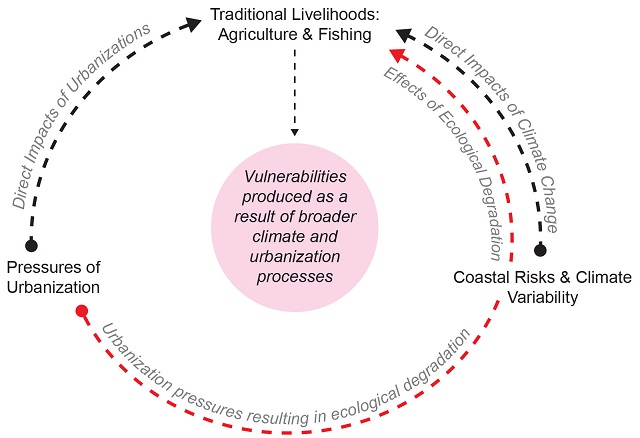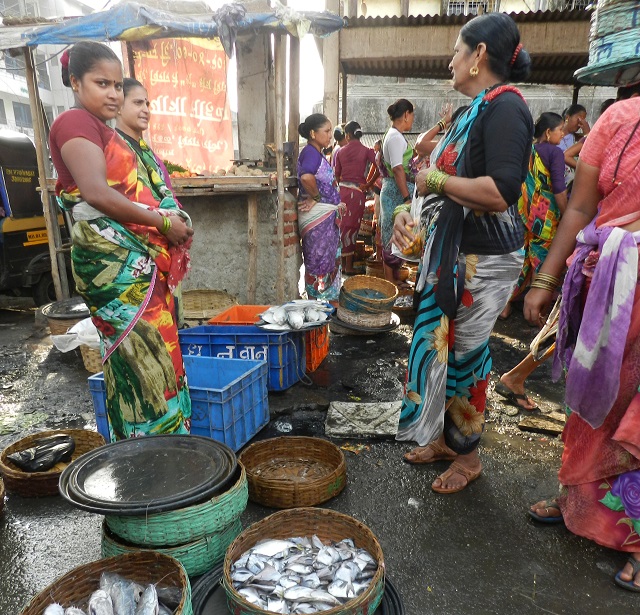Beyond Mitigation: Planning for Resilience outside India’s Mega-Cities
by and -
This blog post originally appeared on TheCityFix
Over the last century, India’s landscape has urbanized considerably: the urban population has grown 14 times since 1901, and by 2050 up to 54 percent of India’s population will be urban (ACCCRN). Much of this urban growth is occurring in large villages or small to medium sized cities (IIHS 2011), resulting in vast ‘peri-urban’ landscapes.
While rapid urbanization is increasing the wealth and spending power of India’s urban population, urban development has also resulted in changes to land use that have challenged traditional industries; agriculture, fishing, and forestry, which are common in peri-urban regions, all face new obstacles. Additionally, climate change and increasingly frequent extreme weather events have posed further issues for both urbanizing communities and these climate-dependent industries. For example, climate change is resulting in an increasingly variable monsoon season, which makes agriculture on the outskirts of cities precarious. Climate change is also increasing sea level and temperature, harming fishing and putting people at risk.
Therefore, climate change action needs to move beyond mitigation and disaster response. Decision makers must plan for climate resilience in ways that protect these vulnerable industries and communities.
The Interconnected Challenges of Urbanization and Climate Change
Consider Arnala village, one of 995 villages in the Mumbai Metropolitan Region and located along the north-western coast. Arnala has a predominantly agrarian and fishing economy and a population of 19,350 people. Using Arnala as a case study, WRI conducted research to document and analyze the interconnected impacts of urbanization and climate change on the livelihoods of fishing and agriculture based communities in peri-urban coastal areas. Villages like Arnala demand attention because due to increasing levels of climate uncertainty and regional pressure, the youth in the village are gradually moving away from the village’s traditional industries.
 Coastal, agrarian economies in India are under pressure from both climate change and urbanization, making the future of these industries highly uncertain. Graphic by Lubaina Rangwala
Coastal, agrarian economies in India are under pressure from both climate change and urbanization, making the future of these industries highly uncertain. Graphic by Lubaina Rangwala
Rapid urbanization in the region and poor waste management systems have resulted in a spike in water pollution, straining the fishing industry. Indeed, urban expansion in coastal cities (or their peripheries) often results in the deterioration of mangroves, threatening fish species and driving profits down for fisheries. Further, due to an overall rise in sea-surface temperature, many native species have already migrated upwards from the southern coast, resulting in species variations along both the east and west coasts of India. These new species are often undesirable to local markets resulting in reduced sales for anglers.
Adding variability to this trend, unseasonal rainfall and flash storms, now common to the region, result in a sudden cooling of the sea’s surface. This impacts fish in two ways: (1) fish recede to the sea bed due to lower surface temperatures, or (2) produce fewer or no eggs as fish primarily lay eggs only when the sea is warmer. All of this makes communities in peri-urban areas, which are dependent on natural ecosystems for their livelihoods, particularly vulnerable to climate change.
Effective and strict climate policies as well as stringent urban development policies can help address the needs of these communities. However, peri-urban areas are often subject to multiple and overlapping institutional and governance jurisdictions, making regulation and enforcement difficult. Therefore, several questions arise, such as: how can urban infrastructure benefit peri-urban communities who are dependent on traditional industries? How can urban planning empower peri-urban communities to adapt to the pressures of urbanization and climate change while planning for a gradual shift in their economies?
 Fishing, a primary source in income in many of India’s coastal villages, is being threatened by urbanization and the effects of increasing temperatures. Photo by World Resources Institute
Fishing, a primary source in income in many of India’s coastal villages, is being threatened by urbanization and the effects of increasing temperatures. Photo by World Resources Institute
Potential Policies for Building Resilience in Peri-Urban India
Many villages and towns within the Mumbai Metropolitan Region fear that urbanization may negatively impact their livelihoods. This anxiety stems from the fact that a majority of villages that have been agglomerated into urban governing bodies are stripped off their autonomy, losing control of their rural economies. These conflicts, coupled with climate uncertainty, create a rather complex political landscape for urban planning at a regional scale. Consequently, a multi-stakeholder and interdisciplinary planning approach should be adopted to adequately address the needs of these changing communities.
Decision makers should consider the following policy entry-points in order to move planning in this direction -
1. Management of Peri-urban Areas: This should include developing guidelines for the assimilation of villages into urban areas. These guidelines should ensure effective regulation to protect fragile ecosystems, and enforcement of building codes to control unplanned developments. State-level regulations should help manage environmental risks as a way of regulating and guiding urban regional planning.
2. Capacity Building: Planning departments often only represent the needs of urban communities since they assume all city residents live, or will live, in an urban environment. However, to effectively manage urbanization in peri-urban areas, it is important to build institutional and planning capacities within planning departments to represent and manage both urban and rural aspirations for development.
3. Knowledge Management: Spreading information about the effects of climate change at the local level and empowering communities to diversify their incomes during off-seasons will be critical for contending with the dual forces of urbanization and climate change.
4. Inclusionary Policies: Local governmental and planning agencies need to develop guidelines that ensure that urban resilience planning accounts for gender and age.
5. Finance Allocations: The state and local governments need to ensure adequate public financing for urban climate resilience planning at both levels.
While WRI India’s study in Arnala reveals the clear impacts of urbanization and climate change on the industries and ecosystems in the peri-urban community, it also presents many opportunities to forge self-sufficient and low-carbon peri-urban futures. Based on WRI’s discussions with community members, various stakeholders and experts in the field, it is clear that the only way forward is to adopt a climate resilience approach to urban planning—including defining key urban development guidelines to plan for resilience on the outskirts of rapidly growing cities.
This article draws on a workshop conducted by WRI in India to discuss the opportunities and challenges of preserving jobs and building urban climate resilience in coastal communities. The event’s intent was to develop a multi-sectoral approach to building urban climate resilience, to address community concerns, utilize scientific evidence about climate change, and find the right planning and policy entry points.


